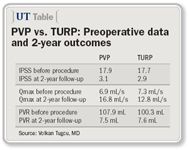Article
PVP, TURP show comparable outcomes at 2 years
Data from two similarly designed European studies comparing photoselective vaporization of the prostate and transurethral resection of the prostate show similar outcomes after a 2-year follow-up in patients with lower urinary tract symptoms due to BPH.
Berlin-Data from two similarly designed European studies comparing photoselective vaporization of the prostate and transurethral resection of the prostate show similar outcomes after a 2-year follow-up in patients with lower urinary tract symptoms due to BPH, researchers reported at the European Association of Urology annual congress here.
Researchers from the University of Basel in Switzerland conducted a non-randomized, two-center, prospective study comparing the postoperative results in 319 patients who underwent PVP (GreenLight Laser, American Medical Systems, Minnetonka, MN) and 136 patients who underwent TURP.
Researchers, led by Robin Ruszat, MD, found that although the two techniques showed comparable functional results, the maximum flow rate (Qmax score) was higher in the TURP group. Younger patients demonstrated a high postoperative Qmax, regardless of operative technique. Also, PVP was seen to be superior in terms of intra-operative safety compared to that seen with TURP, but the re-operation rate was higher in the PVP group.

The transurethral catheter was removed after 1.8 days in the PVP group and after 2.9 days in the TURP group. Old patients, those with large prostates, and those on ongoing oral anticoagulation therapy had the catheter for more than 1 day. Dr. Ruszat said the hospitalization time was significantly shorter in the PVP group (p<.001).
"Our study is biased insofar as the mean age and prostate volume of the patients in the PVP group were significantly higher than in the TURP group. This is certainly due to the fact that more old and sick patients are accepted for a PVP than for a TURP, not that less patients are rejected to undergo TURP because of the high perioperative risk," he said.
Dr. Ruszat was asked whether prostate volume after surgery was analyzed in the study.
"This is difficult to measure with ultrasound, but we saw a decrease in prostate volume of approximately 30% to 40% in the PVP group," he said. "Unfortunately, we have no data on this for the TURP group."
Tullio Sulser, MD, who co-chaired the session, asked how many surgeons were involved in both procedures, and whether the experience of surgeons had an influence on the outcomes of surgery. Dr. Ruszat indicated that there were seven surgeons in the PVP group and three surgeons in the TURP group.
"The learning curve plays a pivotal role in this statistic, and this could possibly explain the high stricture rates seen in our study. Furthermore, we observed no more strictures after we changed our 26 Ch resectoscope to a 22 Ch. We found out that the re-operation rate is associated to the learning curve. In our opinion, the learning curve for the PVP procedure is about 30 operations," Dr. Ruszat said.
Similar study
In a second, similar study, researchers from the Bakirkoy Training and Research Hospital, Istanbul, Turkey, conducted a prospective, two-center, non-randomized 2-year study in which the postoperative results of PVP with the KTP laser (112 patients) were compared to those of TURP (98 patients) in patients with LUTS secondary to BPH.
"Although the PVP and TURP techniques demonstrated similar results postoperatively, the PVP patients had a clear advantage of shorter hospitalization time, as well as shorter catheter-in time, compared to the TURP patients," said first author Volkan Tugcu, MD.




